light Citroen DS4 RHD 2013.5 1.G Workshop Manual
[x] Cancel search | Manufacturer: CITROEN, Model Year: 2013.5, Model line: DS4 RHD, Model: Citroen DS4 RHD 2013.5 1.GPages: 400, PDF Size: 31.86 MB
Page 213 of 400

211Driving
Invalid value during manual
operation
This symbol is displayed if a gear
is not engaged correctly (selector
between two positions).
Stopping the vehicle
Before switching off the engine, you can
engage position P
or N
to place the gearbox in
neutral.
In both cases, apply the parking brake to
immobilise the vehicle, unless it is programmed
to automatic mode.
If the lever is not in position P
, when the
driver's door is opened or approximately
45 seconds after the ignition is switched
off, there is an audible signal and a
message appears.
Return the lever to position P
;
the audible signal stops and the
message disappears.
Operating fault
When the ignition is on, the lighting of this
warning lamp, accompanied by an audible
signal and a message in the multifunction
screen, indicates a gearbox malfunction.
In this case, the gearbox switches to back-up
mode and is locked in 3rd gear. You may feel
a substantial knock when changing from P
to R
and from N
to R
. This will not cause any
damage to the gearbox.
Do not exceed 60 mph (100 km/h), local speed
restrictions permitting.
Have it checked by a CITROËN dealer or a
qualified workshop.
This warning lamp may also come on if a door
is opened.
You risk damaging the gearbox:
- if you press the accelerator and
brake pedals at the same time,
- if you force the lever from position P
to another position when the
battery is flat.
To reduce fuel consumption when
stationary for long periods with the
engine running (traffic jam...), position
the gear lever at N
and apply the
parking brake, unless it is programmed
in automatic mode.
Page 218 of 400
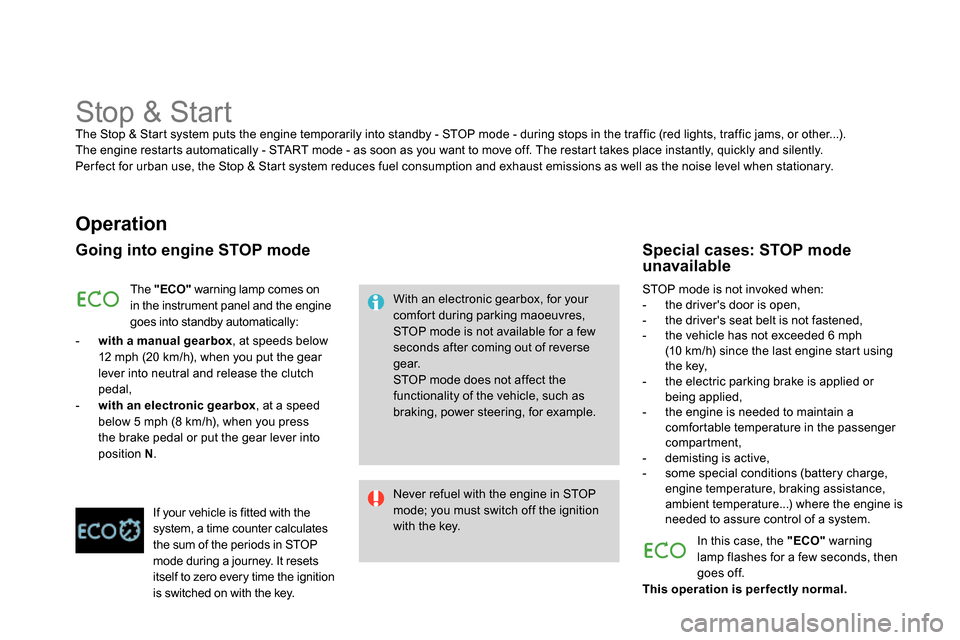
Stop & Start
The Stop & Start system puts the engine temporarily into standby - STOP mode - during stops in the traffic (red lights, traffic jams, or other...).
The engine restarts automatically - START mode - as soon as you want to move off. The restart takes place instantly, quickly and silently.
Per fect for urban use, the Stop & Start system reduces fuel consumption and exhaust emissions as well as the noise level when stationary.
Operation
Going into engine STOP mode
With an electronic gearbox, for your
comfort during parking maoeuvres,
STOP mode is not available for a few
seconds after coming out of reverse
gear.
STOP mode does not affect the
functionality of the vehicle, such as
braking, power steering, for example.
Never refuel with the engine in STOP
mode; you must switch off the ignition
with the key. The "ECO"
warning lamp comes on
in the instrument panel and the engine
goes into standby automatically:
- with a manual gearbox
, at speeds below
12 mph (20 km/h), when you put the gear
lever into neutral and release the clutch
pedal,
- with an electronic gearbox
, at a speed
below 5 mph (8 km/h), when you press
the brake pedal or put the gear lever into
position N
.
If your vehicle is fitted with the
system, a time counter calculates
the sum of the periods in STOP
mode during a journey. It resets
itself to zero every time the ignition
is switched on with the key. STOP mode is not invoked when:
- the driver's door is open,
- the driver's seat belt is not fastened,
- the vehicle has not exceeded 6 mph
(10 km/h) since the last engine start using
the key,
- the electric parking brake is applied or
being applied,
- the engine is needed to maintain a
comfortable temperature in the passenger
compartment,
- demisting is active,
- some special conditions (battery charge,
engine temperature, braking assistance,
ambient temperature...) where the engine is
needed to assure control of a system.
Special cases: STOP mode
unavailable
In this case, the "ECO"
warning
lamp flashes for a few seconds, then
goes off.
This operation is per fectly normal.
Page 222 of 400
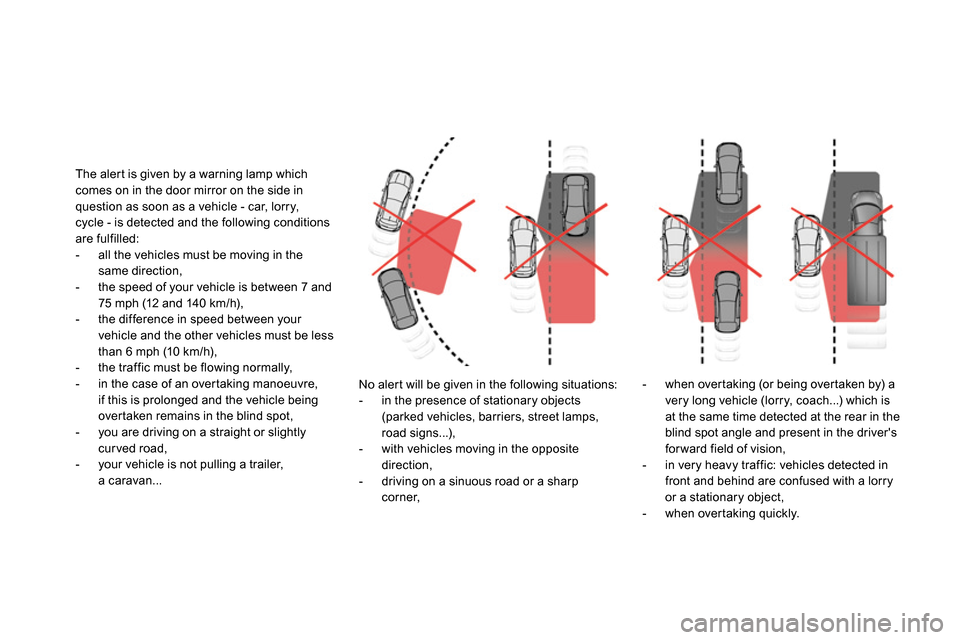
No alert will be given in the following situations:
- in the presence of stationary objects
(parked vehicles, barriers, street lamps,
road signs...),
- with vehicles moving in the opposite
direction,
- driving on a sinuous road or a sharp
corner, The alert is given by a warning lamp which
comes on in the door mirror on the side in
question as soon as a vehicle - car, lorry,
cycle - is detected and the following conditions
are fulfilled:
- all the vehicles must be moving in the
same direction,
- the speed of your vehicle is between 7 and
75 mph (12 and 140 km/h),
- the difference in speed between your
vehicle and the other vehicles must be less
than 6 mph (10 km/h),
- the traffic must be flowing normally,
- in the case of an overtaking manoeuvre,
if this is prolonged and the vehicle being
overtaken remains in the blind spot,
- you are driving on a straight or slightly
cur ved road,
- your vehicle is not pulling a trailer,
a caravan...
- when over taking (or being over taken by) a
very long vehicle (lorry, coach...) which is
at the same time detected at the rear in the
blind spot angle and present in the driver's
for ward field of vision,
- in very heavy traffic: vehicles detected in
front and behind are confused with a lorry
or a stationary object,
- when overtaking quickly.
Page 246 of 400
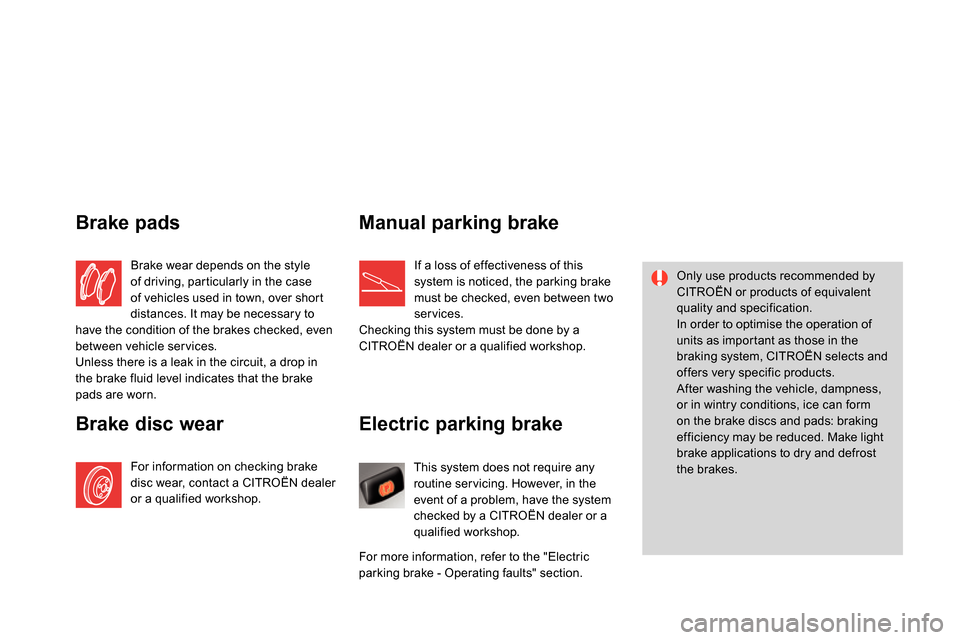
Electric parking brake
This system does not require any
routine ser vicing. However, in the
event of a problem, have the system
checked by a CITROËN dealer or a
qualified workshop.
Only use products recommended by
CITROËN or products of equivalent
quality and specification.
In order to optimise the operation of
units as important as those in the
braking system, CITROËN selects and
offers very specific products.
After washing the vehicle, dampness,
or in wintry conditions, ice can form
on the brake discs and pads: braking
efficiency may be reduced. Make light
brake applications to dry and defrost
the brakes.
Brake disc wear
For information on checking brake
disc wear, contact a CITROËN dealer
or a qualified workshop.
Manual parking brake
If a loss of effectiveness of this
system is noticed, the parking brake
must be checked, even between two
services.
Checking this system must be done by a
CITROËN dealer or a qualified workshop.
Brake pads
Brake wear depends on the style
of driving, particularly in the case
of vehicles used in town, over short
distances. It may be necessary to
have the condition of the brakes checked, even
between vehicle ser vices.
Unless there is a leak in the circuit, a drop in
the brake fluid level indicates that the brake
pads are worn.
For more information, refer to the "Electric
parking brake - Operating faults" section.
Page 263 of 400
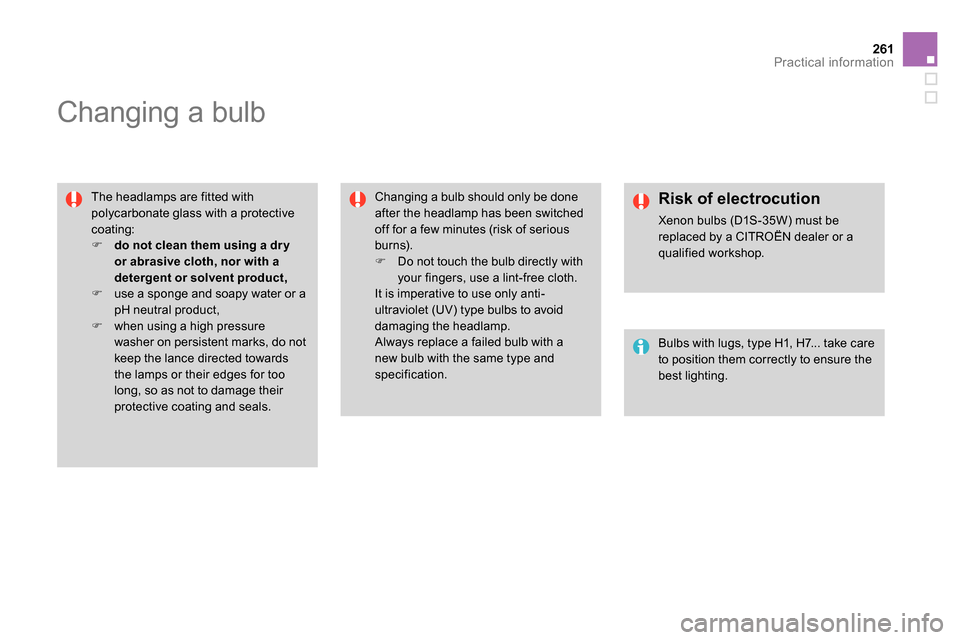
261Practical information
Changing a bulb
The headlamps are fitted with
polycarbonate glass with a protective
coating:
do not clean them using a dr y
or abrasive cloth, nor with a
detergent or solvent product,
use a sponge and soapy water or a
pH neutral product,
when using a high pressure
washer on persistent marks, do not
keep the lance directed towards
the lamps or their edges for too
long, so as not to damage their
protective coating and seals. Changing a bulb should only be done
after the headlamp has been switched
off for a few minutes (risk of serious
burns).
Do not touch the bulb directly with
your fingers, use a lint-free cloth.
It is imperative to use only anti-
ultraviolet (UV) type bulbs to avoid
damaging the headlamp.
Always replace a failed bulb with a
new bulb with the same type and
specification.
Risk of electrocution
Xenon bulbs (D1S-35W) must be
replaced by a CITROËN dealer or a
qualified workshop.
Bulbs with lugs, type H1, H7... take care
to position them correctly to ensure the
best lighting.
Page 273 of 400

271Practical information
Fusebox 1
Fuse N°
Rating
Functions
F8
3 A
Alarm siren, alarm ECU.
F13
10 A
Cigarette lighter.
F14
10 A
12 V socket in boot.
F16
3 A
Lighting for the large multifunctional storage unit, rear map
reading lamps, glove box illumination.
F17
3 A
Sun visor illumination, front map reading lamps.
F28
15 A
Audio system, radio (after-market).
F30
20 A
Rear wiper.
F32
10 A
Hi-Fi amplifier.
Fusebox 2
Fuse N°
Rating
Functions
F36
15 A
Rear 12 V socket.
F37
-
Not used.
F38
-
Not used.
F39
-
Not used.
F40
-
Not used.
Fuse tables
Page 285 of 400

283Practical information
Towing a trailer
Towbar suitable for the attachment of a trailer or installation of a bicycle carrier, with additional
lighting and signalling.
We recommend the use of genuine
CITROËN towbars and their harnesses
that have been tested and approved
from the design stage of your vehicle,
and that the fitting of the towbar is
entrusted to a CITROËN dealer or a
qualified workshop.
If the towbar is not fitted by a CITROËN
dealer, it is imperative that it is
fitted in accordance with the vehicle
manufacturer's instructions.
Your vehicle is primarily designed for
transporting people and luggage, but it may
also be used for towing a trailer.
Driving with a trailer places greater
demands on the towing vehicle and the
driver must take particular care.
Page 286 of 400
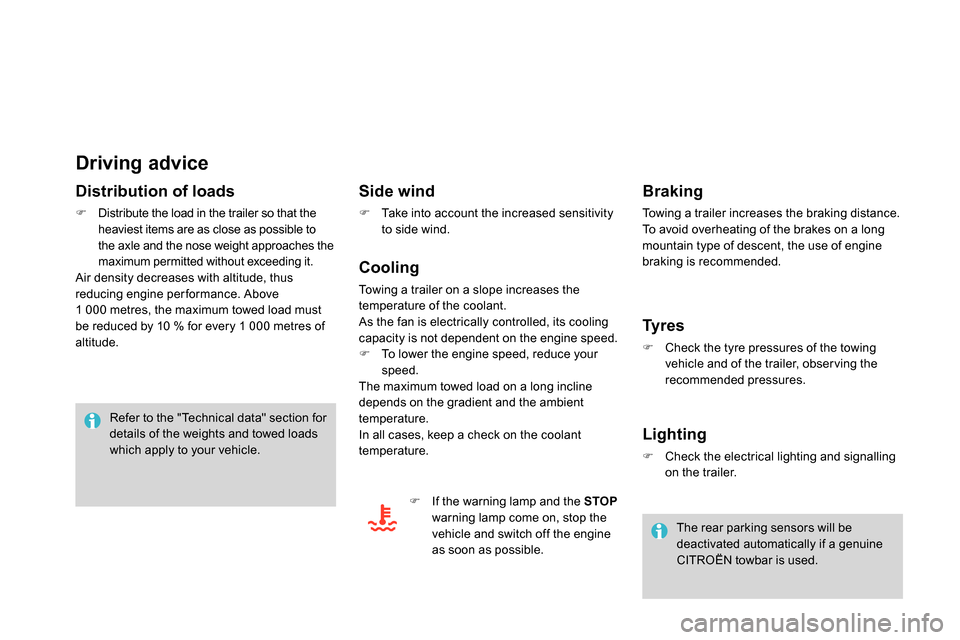
Driving advice
Distribution of loads
Distribute the load in the trailer so that the
heaviest items are as close as possible to
the axle and the nose weight approaches the
maximum permitted without exceeding it.
Air density decreases with altitude, thus
reducing engine per formance. Above
1 000 metres, the maximum towed load must
be reduced by 10 % for every 1 000 metres of
altitude.
Side wind
Take into account the increased sensitivity
to side wind.
Cooling
Towing a trailer on a slope increases the
temperature of the coolant.
As the fan is electrically controlled, its cooling
capacity is not dependent on the engine speed.
To lower the engine speed, reduce your
speed.
The maximum towed load on a long incline
depends on the gradient and the ambient
temperature.
In all cases, keep a check on the coolant
temperature.
If the warning lamp and the STOP
warning lamp come on, stop the
vehicle and switch off the engine
as soon as possible.
The rear parking sensors will be
deactivated automatically if a genuine
CITROËN towbar is used.
Braking
Towing a trailer increases the braking distance.
To avoid overheating of the brakes on a long
mountain type of descent, the use of engine
braking is recommended.
Ty r e s
Check the tyre pressures of the towing
vehicle and of the trailer, obser ving the
recommended pressures.
Lighting
Check the electrical lighting and signalling
on the trailer.
Refer to the "Technical data" section for
details of the weights and towed loads
which apply to your vehicle.
Page 293 of 400
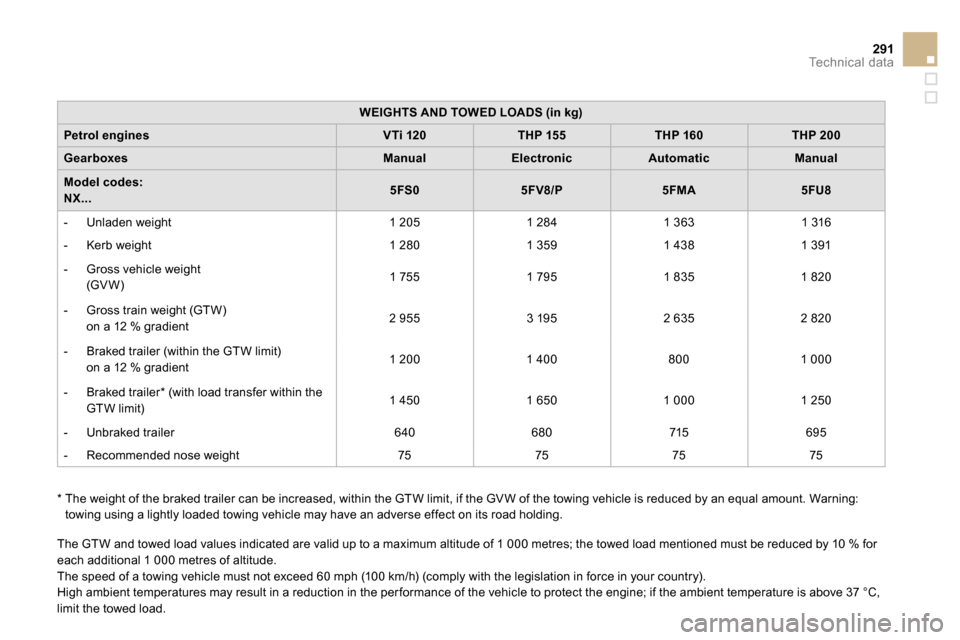
291Te c h n i c a l d a t a
WEIGHTS AND TOWED LOADS (in kg)
Petrol engines
VTi 120
THP 155
THP 160
THP 200
Gearboxes
Manual
Electronic
Automatic
Manual
Model codes:
NX...
5FS0
5FV8/P
5FMA
5FU8
- Unladen weight
1 205
1 284
1 363
1 316
- Kerb weight
1 280
1 359
1 438
1 391
- Gross vehicle weight
(GV W)
1 755
1 795
1 835
1 820
- Gross train weight (GTW)
on a 12 % gradient
2 955
3 195
2 635
2 820
- Braked trailer (within the GTW limit)
on a 12 % gradient
1 200
1 400
800
1 000
- Braked trailer * (with load transfer within the
GTW limit)
1 450
1 650
1 000
1 250
- Unbraked trailer
640
680
715
695
- Recommended nose weight
75
75
75
75
The GTW and towed load values indicated are valid up to a maximum altitude of 1 000 metres; the towed load mentioned must be reduced by 10 % for
each additional 1 000 metres of altitude.
The speed of a towing vehicle must not exceed 60 mph (100 km/h) (comply with the legislation in force in your country).
High ambient temperatures may result in a reduction in the per formance of the vehicle to protect the engine; if the ambient temperature is above 37 °C,
limit the towed load.
*
The weight of the braked trailer can be increased, within the GTW limit, if the GV W of the towing vehicle is reduced by an equal amount. Warning:
towing using a lightly loaded towing vehicle may have an adverse effect on its road holding.
Page 295 of 400

293Te c h n i c a l d a t a
WEIGHTS AND TOWED LOADS (in kg)
Diesel engines
HDi 90 PEF
HDi 110 PEF
e- HDi 110 PEF
HDi 160 PEF
Gearbox
Manual
Manual
Manual
Electronic
Manual
Automatic
Model codes:
NX...
9HP0
9HR8
9HR8/S
9HR8/PS
RHH8
RHHA
- Unladen weight
1 205
1 290
1 295
1 300
1 320
1 430
- Kerb weight
1 280
1 365
1 370
1 375
1 395
1 505
- Gross vehicle weight
(GV W)
1 765
1 805
1 810
1 815
1 880
1 940
- Gross train weight (GTW)
on a 12 % gradient
2 865
3 105
3 110
3 115
3 180
3 140
- Braked trailer (within GTW limit)
on 12 % gradient
1 100
1 300
1 300
1 300
1 300
1 200
- Braked trailer * (with load transfer with
the GTW limit)
1 350
1 550
1 550
1 550
1 550
1 450
- Unbraked trailer
640
680
680
680
695
750
- Recommended nose weight
75
75
75
75
75
75
The GTW and towed load values indicated are valid up to a maximum altitude of 1 000 metres; the towed load mentioned must be reduced by 10 % for
each additional 1 000 metres of altitude.
The speed of a towing vehicle must not exceed 60 mph (100 km/h) (comply with the legislation in force in your country).
High ambient temperatures may result in a reduction in the per formance of the vehicle to protect the engine; if the ambient temperature is above 37 °C,
limit the towed load.
*
The weight of the braked trailer can be increased, within the GTW limit, if the GV W of the towing vehicle is reduced by an equal amount. Warning:
towing using a lightly loaded towing vehicle may have an adverse effect on its road holding.